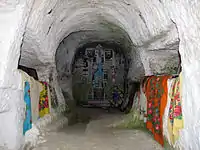Bakota, Ukraine
Bakota (Ukrainian: Ба́кота) is a historic submerged settlement of the Rus Kingdom, modern-day Khmelnytskyi Oblast (province) in western Ukraine. The village lies beneath the Dniester River and is located in the historical Podillia region.
Bakota
Ба́кота | |
|---|---|
Historic settlement | |
 The Dniester River's shore near Bakota's rocky hills. | |
| Coordinates: 48°35′35″N 26°58′44″E | |
| Country | |
| Oblast | Khmelnytskyi Oblast |
| Raion | Kamianets-Podilskyi Raion |
| First mentioned | 1240[1] |
| Elevation | 110−130 m (360−426 ft) |
| Time zone | UTC+2 (EET) |
| • Summer (DST) | UTC+3 (EEST) |
Bakota has an ancient Orthodox cave monastery (48.585647°N, 26.999702°E), which includes ancient frescoes and paintings dating back to the 12th-14th centuries,[1] as well as preserved remains of monks.[3] Local legend has it that the Bakota Cave Monastery was founded by Saint Anthony of Kiev, who also founded the historic Kiev Pechersk Lavra in 1051, now in Kyiv, Ukraine.[4] A Paleolithic archaeological site is also located near the village.[1] Bakota is currently part of the National Environmental Park "Podilski Tovtry".


History
Bakota was first mentioned in the Hypatian Chronicle in the year 1240.[1] When the town was first settled, the town was part of the state of Kievan Rus', until the middle of the 12th century when it became a part of the Halych-Volhynian Kingdom.[5] In the 13th century, Bakota served as the political and administrative center of the Dniester Lowland (Ponyzzia), which was at the time part of Halych-Volhynia.[3] The chronicle also mentions the rule of the Koriatovych dynasty over the area in 1362.[4]
After being ruled by the Koriatovych dynasty, the town was controlled by Algirdas, a monarch of the medieval Grand Duchy of Lithuania.[5] The Lithuanian Chronicle of 1362 mentions that a functioning cave monastery exists within the town.[5] This motivated the construction of fortifications, to protect the town from Crimean Tatar raids.[5] In 1431, Bakota was located and shared between the Grand Duchy of Lithuania and the Kingdom of Poland. Bakota's inhabitants later started a revolt and proclaimed their independence, which was crushed by Poland within three years[5] The town's fortifications and castle were also destroyed.[5]
In 1893, in place of a formerly standing church, a new wooden one was constructed, founded by the Episcop of Podillia and Bratslav Dmitry.[4][6] The church was destroyed in 1960. On October 27, 1981, the village of Bakota was flooded when the New Dniester Hydroelectric Station was built. The village's inhabitants were moved from the area and re-settled not far away. In 1996, large portions of Bakota's rocky hills broke off and buried most of the village's ancient caves.
Notable residents
- Faina Melnik, Olympic champion discus thrower.[7]
References
- "Bakota". Encyclopedia of Ukraine. Retrieved 2007-10-07.
- "Bakota". nebo.kiev.ua (in Russian). Archived from the original on 2007-08-14. Retrieved 2007-10-07.
- "Khmelnytskiy (1493, 260.1 inhabitants)". Magistral (in Russian). Archived from the original on 12 October 2007. Retrieved 2007-10-07.
- Kuzin, Volodymyr. "Bakota". castles.com.ua (in Ukrainian). Archived from the original on 11 October 2007. Retrieved 2007-10-07.
- "Bakota". Architectural and environmental Monuments of Ukraine (in Ukrainian). Archived from the original on 27 October 2007. Retrieved 2007-10-07.
- "Rock monastery, end of 13-middle 14th c." in "Monuments of architecture of Ukrainian SSR," edited by N. L. Zharikov, Kiev, "Budivelʹnyk", 1983-1986, LCCN 84-179019 (in Russian)
- "Faina Melnik". sporting-heroes.net. Archived from the original on 13 November 2007. Retrieved 2007-10-07.
External links
- "Cave monastery. 14th century. Item №1686". National Environmental Park "Podilski Tovtry" (in Russian). Archived from the original on 11 November 2007. Retrieved 2007-10-07.
- "Rock-cave Sviaty-Mykhailivskyi Monastery". bakota.narod.ru (in Ukrainian). Archived from the original on 25 August 2007. Retrieved 2007-10-07.